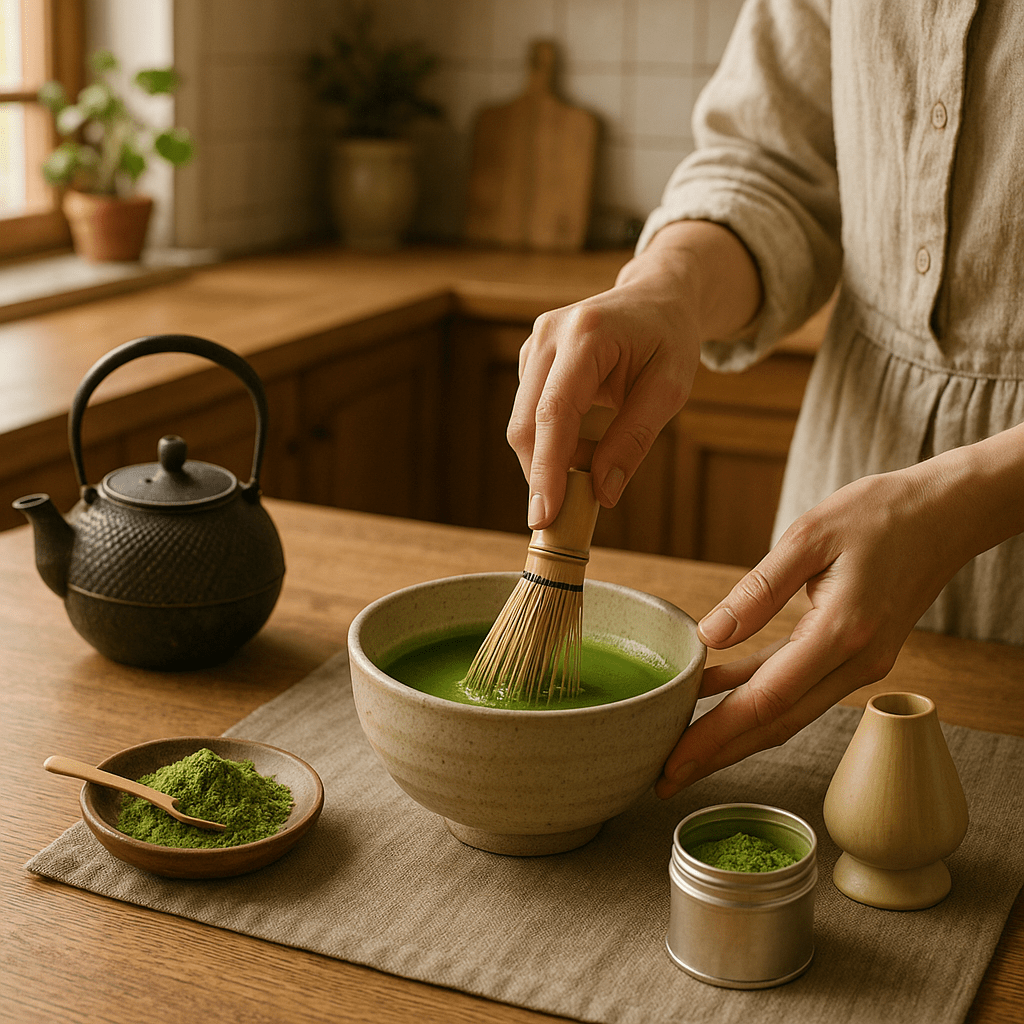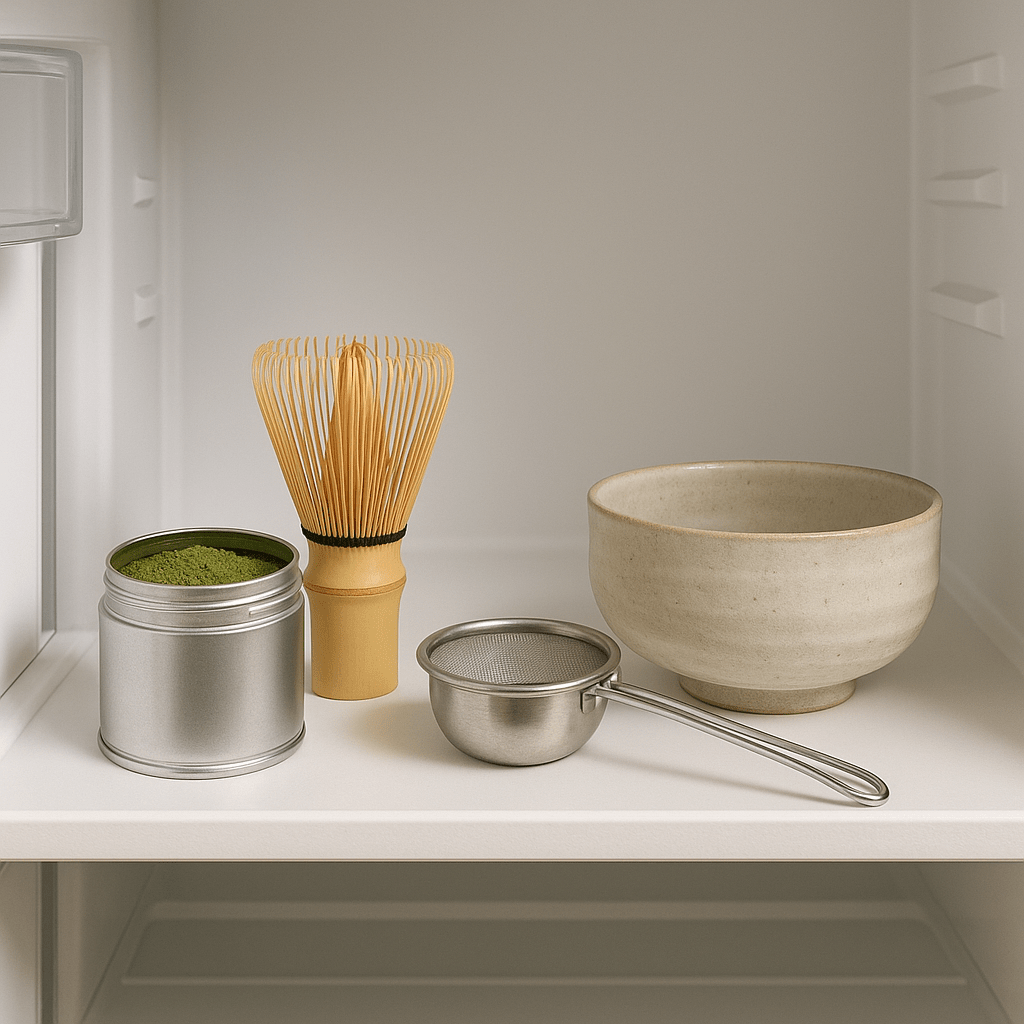Matcha is a unique, finely ground green tea powder that has been used in traditional Japanese tea ceremonies for centuries. Unlike regular tea, which is brewed with tea leaves, matcha is consumed whole leaf – the powder is mixed with water, resulting in a rich, refreshing drink texture and a full spectrum of nutrients. Today, matcha is growing in popularity around the world not only for its rich flavor, but also for its many health benefits – from its abundance of antioxidants to its natural energy source that, unlike coffee, does not give you a jittery feeling.
While matcha may seem like a simple type of tea, its proper preparation is an art form that requires certain knowledge and skills. The correct preparation process allows you to get the best taste and maximum benefits. To learn more about the unique properties of ceremonial matcha, you can visit this antioxidant resource page.
In this article, you will learn how to properly prepare authentic matcha tea at home, what tools you will need, what are the main preparation steps and how to avoid common mistakes. You will also learn about the different methods of preparing matcha and where to buy quality matcha and the tools for it.
What you need to know before preparing matcha tea
Quality matcha and the right tools are the basis for successful preparation.
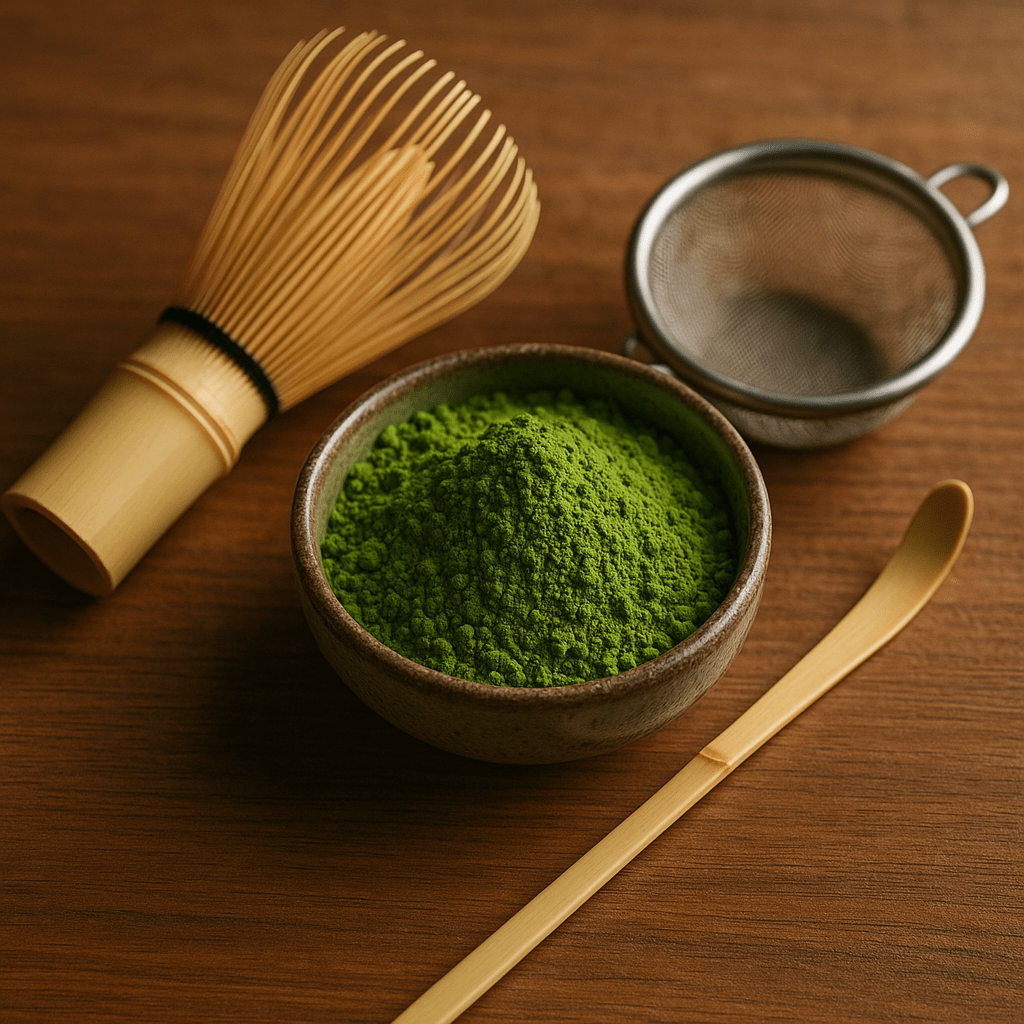
To enjoy a true matcha experience at home, it is necessary to pay attention to several essential aspects – the quality of the tea, the necessary tools, the water temperature and the preparation method.
Basic matcha tools and their purpose
Traditional preparation of matcha tea requires special tools, each of which performs an important function:
- Chawan (tea bowl) – a special, wide ceramic bowl in which matcha is shaken and drunk. Its shape provides enough space for stirring the tea.
- Chasen (bamboo whisk) – a traditional Japanese bamboo whisk with approximately 80-100 bristles, specially designed for whisking matcha. A real Japanese matcha whisk ensures a creamy consistency and prevents lumps from forming.
- Chashaku (bamboo spoon) – a special long spoon for dosing matcha powder. One teaspoon corresponds to approximately 1-1.5 grams of matcha powder.
- Furui (strainer) – A fine sieve that helps prevent matcha powder from clumping. Sifting the powder through it results in a smoother, more consistent drink.
While traditional tools provide an authentic experience, beginners can start with simpler alternatives such as a small sieve, a frosted whisk or even an electric cappuccino frother. However, the true matcha experience is achieved using traditional tools that allow you to feel the Japanese tea culture and tradition.
The quality of ceremonial matcha is also extremely important – it should be bright green in color, with a delicate flavor with hints of sweet, green notes. The best ceremonial matcha is made from the youngest leaves of the tea tree, grown in gentle shade, which ensures a milder flavor and higher antioxidant content.
How to Make Matcha Tea Step by Step
Making matcha at home can become a daily ritual that not only helps you enjoy a delicious drink, but also helps you find a moment of peace. Here is a detailed step-by-step guide to making the perfect matcha tea.
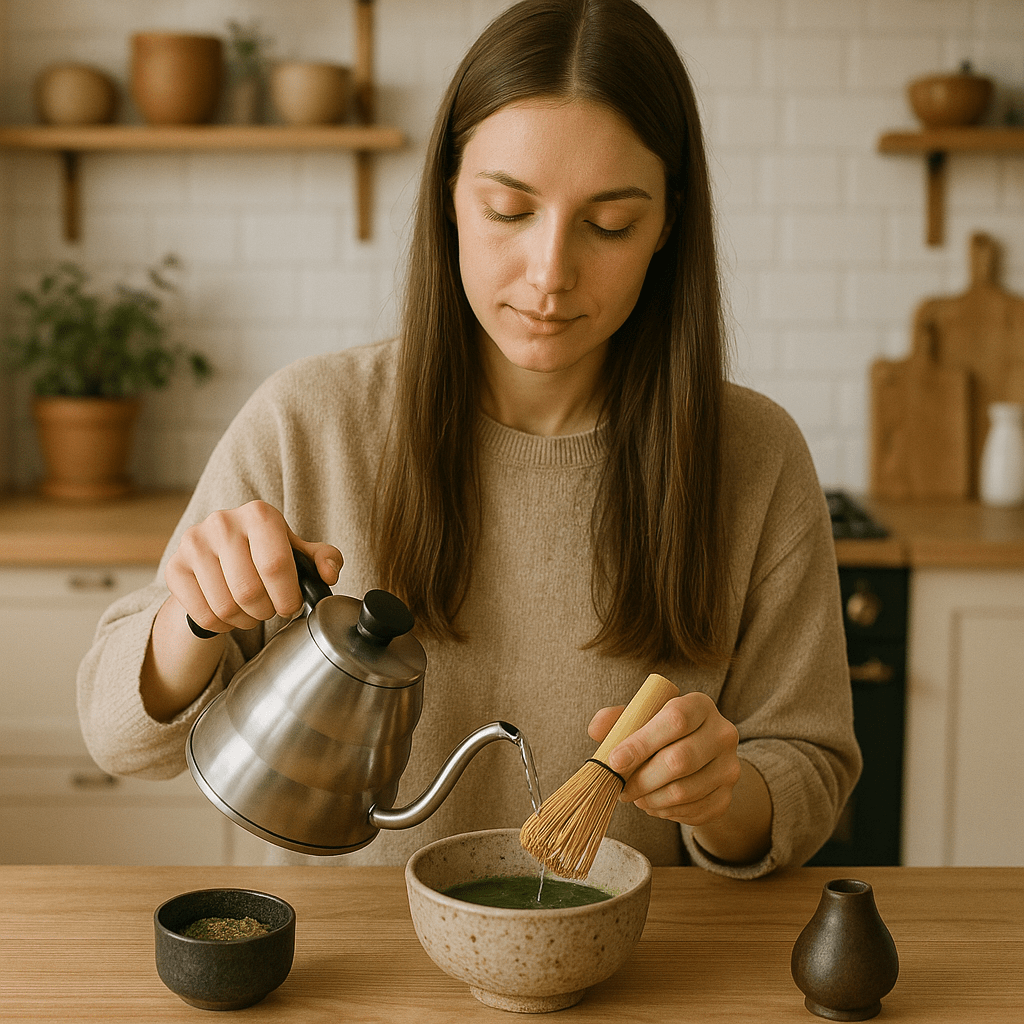
Preparation and Necessary Products
Before you start making matcha, make sure you have:
- 1-2 g (approximately 1/2-1 teaspoon or 1 chashaku) of good quality matcha
- 70-80 ml of hot water (60-80°C)
- A tea bowl (chawan)
- A bamboo whisk (chasen)
- A bamboo spoon (chashaku)
- A strainer (furui)
Steps to prepare matcha tea
- Preparing the tools: Warm the chawan by pouring a little hot water and swirling it to warm the sides of the bowl. Pour out the water and dry the bowl thoroughly. This step helps maintain the right temperature of the tea and enhances its aroma.
- Sifting the matcha: Sift 1-2 grams of matcha powder into a bowl through a sieve. Sifting helps prevent lumps and ensures an even distribution of the powder.
- Water temperature: Boil water and let it cool to 60-80°C. Water that is too hot can ruin the taste of matcha, making it bitter, while water that is too cold will prevent the tea’s aromas from developing properly. Check out this matcha tea strainer tutorial for a better understanding of how to properly prepare your tools.
- Adding water: Add a small amount of water (about 30 ml) to the bowl with matcha and immediately start whisking to form a paste. Then add the remaining water (up to 70-80 ml).
- Whisking technique: Holding the chasen whisk perpendicular to the bowl, whisk the matcha in a “W” or “M” shape, quickly and lightly, so as not to create too many bubbles. Whisk for 15-20 seconds, until a small, uniform foam forms on the surface and the powder is completely dissolved.
- Enjoying: Drink your matcha immediately after preparation, while it is still warm and the foam has not broken down. Traditionally, matcha is drunk in three sips, holding the bowl with both hands.
Different Preparation Methods
Traditional usucha (more liquid matcha)
Usucha is the most common method of preparing matcha, which produces a more liquid, lighter drink. It uses less matcha powder (1-1.5 g) and more water (70-80 ml). This preparation method creates a more subtle, slightly bitter taste and is perfect for everyday consumption.
Traditional koicha (thicker matcha)
Koicha is a thicker version of matcha, traditionally used in formal tea ceremonies. It uses twice as much matcha powder (3-4 g) and less water (about 40 ml). The result is a thick, almost syrupy tea with an intense flavor. Only the highest quality ceremonial matcha is used to prepare koicha.
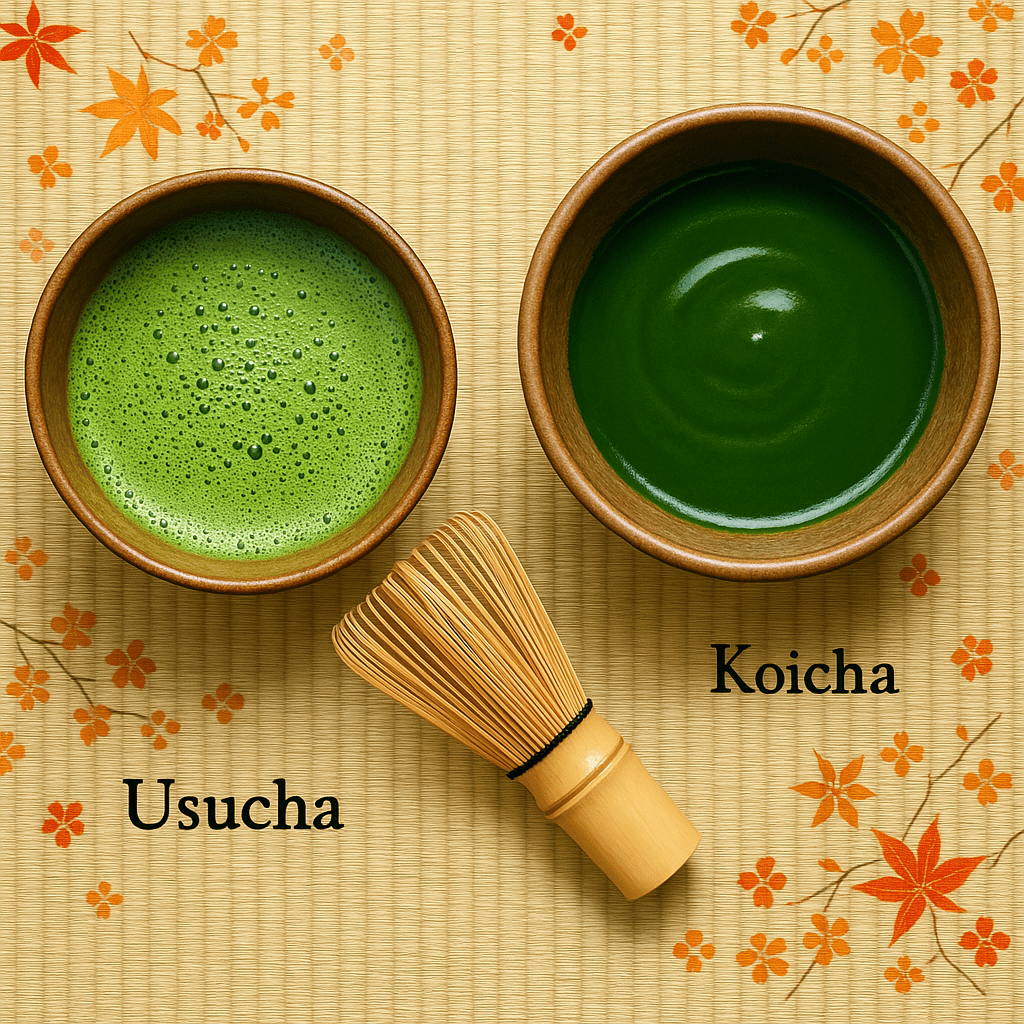
Modern preparation with an electric whisk
If you don’t have a traditional bamboo whisk, you can use an electric milk frother. Place the matcha in a bowl, add water and whisk on low speed until the powder is completely dissolved and a small foam forms. This method is more convenient, but it does not achieve the same delicate taste as using a traditional whisk.
Matcha latte and other variations
Matcha latte recipe
Matcha latte is a popular Western version of matcha:
- Mix 1-2 g of matcha powder with 30 ml of hot water, whisk until smooth.
- Heat 150-180 ml of milk (cow, soy, almond or other plant-based milk can be used).
- Pour the milk into the prepared matcha, whisk again or mix with a spoon.
- You can add a little honey, agave or maple syrup to taste.
Cold matcha
On a hot day, you can enjoy chilled matcha:
- Prepare matcha as usual, using warm water.
- Pour into a glass with ice.
- You can add a slice of lemon or a mint leaf for a refreshing taste.
Matcha smoothie
A quick and nutritious breakfast option:
- Put 1 g of matcha powder, 1 banana, some spinach, 1 tablespoon of Greek yogurt, 200 ml of almond milk and honey to taste in a blender.
- Blend everything until smooth.
- Regardless of the preparation method you choose, the most important thing is to use high-quality matcha and follow the water temperature recommendations exactly to get the best taste and preserve the valuable properties of matcha.
Matcha Tea Benefits and Common Mistakes
Matcha tea is not only known for its unique taste, but also for its impressive concentration of nutrients. However, to get the most out of it and enjoy its true flavor, it is important to avoid common preparation mistakes.
Health Benefits of Matcha Tea
- Source of Antioxidants: Matcha is particularly rich in catechins, especially epigallocatechin gallate (EGCG), powerful antioxidants that help neutralize free radicals and protect cells from damage.
- Balanced Energy: Matcha contains a unique combination of L-theanine and caffeine, which provides long-lasting energy without the jitters, jitters, or sudden energy drops often experienced after coffee.
- Improved Concentration: L-theanine, an amino acid found in matcha, increases alpha wave activity in the brain, promoting alertness and concentration, while reducing stress levels.
- Boosts Metabolism: Studies show that regular consumption of matcha can increase metabolic rate and help burn calories.
- Detoxification: Matcha is grown in the shade, which promotes the production of chlorophyll. Chlorophyll can help remove toxic metals and chemicals from the body.
- Heart Health: Regular consumption of matcha can help reduce “bad” cholesterol (LDL) levels and increase “good” cholesterol (HDL), promoting heart health.
Learn more about the different types of matcha and tea and their health benefits.
Common Mistakes When Brewing Matcha
- Water That’s Too Hot: One of the most common mistakes is brewing matcha with water that’s too hot (over 80°C). This causes excessive bitterness and destroys the delicate flavor of matcha and some of its beneficial substances. The ideal temperature is 60-80°C.
- Using poor quality matcha: Culinary grade matcha, intended for baking or desserts, is not suitable for making a traditional matcha drink. It tends to have a bitter and dusty consistency. Always use ceremonial grade matcha for drinking.
- Improper whisking technique: Matcha should be whisked in a “W” or “M” shape, rather than simply swirling in a circle like regular tea. Improper whisking results in a lumpy, uneven tea.
- Not paying enough attention to the amount of water: Too much water can “dilute” the flavor of the matcha, while too little can create a consistency that’s too thick. Make sure you use the correct ratio of matcha to water (usually 1-2g of matcha to 70-80ml of water).
- Storing matcha in the wrong conditions: Matcha is sensitive to light, heat and humidity. If it is not stored in an airtight container or refrigerated, it will quickly lose its aroma, colour and nutritional properties.
- Not sifting the matcha powder: Skipping the sifting step often results in lumpy tea. Sifting helps to achieve a smooth consistency.
- Rushing the whisking: Whisking matcha requires time and patience. Whisking too quickly prevents foam from forming and does not ensure the powder is completely dissolved.
Avoiding these mistakes and following the correct preparation process will ensure that matcha reveals its subtle, sweet green flavour with a pleasant, creamy nutty note. At the same time, you will ensure that you get the maximum health benefits of this special tea.
Where to Buy Quality Matcha and Tools
Quality matcha tea and the right tools are key to enjoying an authentic matcha experience at home. However, the abundance of products available in Lithuania and online can be confusing, especially for novice matcha enthusiasts.
How to identify quality matcha
When choosing matcha tea, pay attention to the following quality characteristics:
- Color: High-quality ceremonial matcha should be bright green with a slight blue tint. A pale, yellowish or brown color indicates lower quality.
- Texture: High-quality matcha is extremely fine, almost silky, with no noticeable grains or roughness.
- Place of origin: The best matcha is traditionally produced in Japan, especially in the Uji region (Kyoto Prefecture), the Nishi region (Aichi Prefecture) or the Kagoshima region.
- Taste: Ceremonial matcha has a delicate, mild taste with sweet natural hints and a minimal note of bitterness. Culinary matcha is usually more bitter.
- Price: Good quality matcha is not cheap – the price of 30 g of quality ceremonial matcha usually starts at 25-30 euros.
- Certifications: Look for organic certifications, such as JAS (Japanese Agricultural Standard) or USDA Organic.
Matcha Classification
Matcha tea is divided into several categories based on quality:
- Ceremonial Grade: The highest quality matcha, made from the youngest tea leaves for traditional tea drinking. It has a subtle, pleasant flavor and a bright green color.
- Premium Grade: High-quality matcha, suitable for both drinking and culinary use. Its flavor is slightly stronger than ceremonial grades.
- Culinary Grade: A less subtle matcha, often used in baked goods, ice cream, cocktails, and other dishes. It has a stronger, more bitter flavor that does not disappear when mixed with other ingredients.
Where to buy matcha in Lithuania and online
- Specialized tea shops: There are several specialized tea shops in major cities where you can find quality matcha and tools to prepare it.
- Organic and health food stores: Often offer quality organic matcha, although the selection may be limited.
- Online stores: Specialized tea e-stores often have the widest selection of matcha and its tools. Look for stores that cooperate directly with Japanese manufacturers.
- International trading platforms: Here you can find a wide range of matcha and tools, but be careful – check the ratings and reviews of the sellers about the quality of the product.
You can find a category of useful matcha and tea products here, where a wide range of quality products is presented.
Beginner’s Tool Kits
If you are just starting out on your matcha journey, it is worth considering a starter tool kit, which usually includes:
- Bamboo whisk (chasen)
- Traditional tea bowl (chawan)
- Bamboo spoon (chashaku)
- A sieve for sifting matcha
- A small amount of quality ceremonial matcha
Such a kit costs between 50 and 100 euros, depending on the quality and configuration of the tools. It is a great investment for beginners who want to experience the authentic process of preparing matcha.
Storing Matcha
Once you have purchased quality matcha, it is important to store it properly to preserve its flavor and nutritional properties:
- Store matcha in a tightly closed container, protected from light.
- It is best to store matcha in the refrigerator to keep it fresh
- Avoid moisture – always use a dry spoon.
- Try to use up opened matcha within 1-2 months for the best flavor.
By investing in quality matcha and the right tools, you will create the foundation for an authentic and enjoyable matcha ritual that will not only enrich your day, but also provide long-term health benefits.
Conclusion
Making matcha tea at home is not only a way to enjoy a delicious drink, but also an opportunity to create your own personal ritual that helps you find peace in your busy everyday life. Using quality ceremonial matcha, traditional tools and following the correct preparation steps, you will get a delicately flavored, rich green drink filled with valuable antioxidants and other beneficial substances.
Whether you are preparing traditional matcha, a modern matcha latte or experimenting with cold cocktails, the most important thing is to pay attention and patience to the process. Every movement of the matcha, every drop of water contributes to the final result.
Start by purchasing a quality matcha and a basic set of tools. Practice whisking the matcha in a “W” shape, watch the soft foam form, and enjoy the bright color and aroma. Over time, preparing matcha tea can become not only a pleasant routine, but also a moment of mindful presence that takes you away from the hustle and bustle of everyday life.
Whether you are a long-time matcha fan or just starting your journey into this green world, preparing matcha properly at home is an art that is worth perfecting – for the taste, health, and experience it provides.
Frequently Asked Questions (FAQs)
What is the ideal temperature for preparing matcha tea at home?
The ideal water temperature for preparing matcha is 60-80°C. This temperature ensures a smooth taste and preserves valuable nutrients. Water that is too hot can add bitterness, while water that is too cold will not help the tea’s flavor develop properly.
Do I need a special matcha whisk or can I use a regular kitchen whisk?
A bamboo matcha whisk (chasen) creates the best texture and prevents lumps. An electric whisk can be an alternative, but it does not provide the same texture and delicate flavor that can be achieved with a traditional bamboo whisk.
Can I use matcha in recipes other than tea?
Yes, matcha is great for a variety of recipes. It is often used in smoothies, baked goods, and desserts to add extra flavor and nutritional value. For culinary purposes, it is best to use special culinary matcha, which is less expensive and has a stronger flavor.
How to recognize quality matcha?
Quality matcha has a bright green color, a soft texture, and is made by reliable Japanese manufacturers. Look for matcha that is produced in the Uji, Nishi, or Kagoshima regions and is certified organic. Good quality matcha cannot be cheap.
What are the most common mistakes when making matcha?
The most common mistakes are: using boiling water, choosing poor quality matcha, improper whisking technique, not sifting the powder, and whisking too quickly. These mistakes can lead to a bitter, lumpy drink without a subtle flavor and foam.

